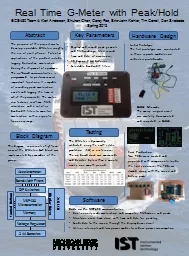PPT-The purpose of this project was to develop a portable G-Meter, roughly the size of a cell
Author : min-jolicoeur | Published Date : 2018-02-22
include logging destructive acceleration during the shipment of a packages The onboard microcontroller is programmed to perform several important functions It is
Presentation Embed Code
Download Presentation
Download Presentation The PPT/PDF document "The purpose of this project was to devel..." is the property of its rightful owner. Permission is granted to download and print the materials on this website for personal, non-commercial use only, and to display it on your personal computer provided you do not modify the materials and that you retain all copyright notices contained in the materials. By downloading content from our website, you accept the terms of this agreement.
The purpose of this project was to develop a portable G-Meter, roughly the size of a cell: Transcript
Download Rules Of Document
"The purpose of this project was to develop a portable G-Meter, roughly the size of a cell"The content belongs to its owner. You may download and print it for personal use, without modification, and keep all copyright notices. By downloading, you agree to these terms.
Related Documents














